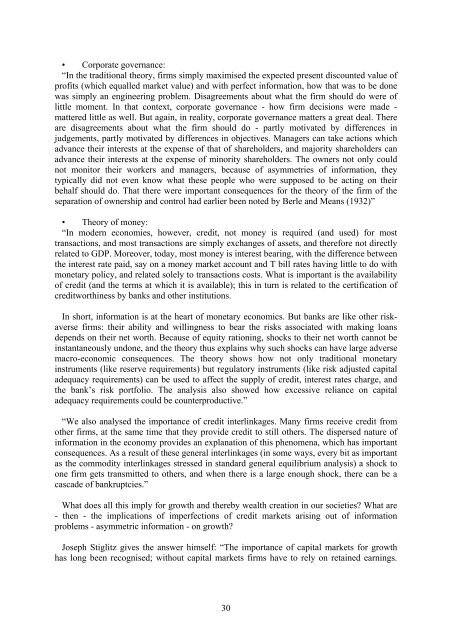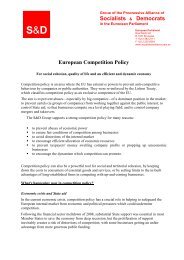Executive summary - Udo Bullmann
Executive summary - Udo Bullmann
Executive summary - Udo Bullmann
- No tags were found...
Create successful ePaper yourself
Turn your PDF publications into a flip-book with our unique Google optimized e-Paper software.
• Corporate governance:“In the traditional theory, firms simply maximised the expected present discounted value ofprofits (which equalled market value) and with perfect information, how that was to be donewas simply an engineering problem. Disagreements about what the firm should do were oflittle moment. In that context, corporate governance - how firm decisions were made -mattered little as well. But again, in reality, corporate governance matters a great deal. Thereare disagreements about what the firm should do - partly motivated by differences injudgements, partly motivated by differences in objectives. Managers can take actions whichadvance their interests at the expense of that of shareholders, and majority shareholders canadvance their interests at the expense of minority shareholders. The owners not only couldnot monitor their workers and managers, because of asymmetries of information, theytypically did not even know what these people who were supposed to be acting on theirbehalf should do. That there were important consequences for the theory of the firm of theseparation of ownership and control had earlier been noted by Berle and Means (1932)”• Theory of money:“In modern economies, however, credit, not money is required (and used) for mosttransactions, and most transactions are simply exchanges of assets, and therefore not directlyrelated to GDP. Moreover, today, most money is interest bearing, with the difference betweenthe interest rate paid, say on a money market account and T bill rates having little to do withmonetary policy, and related solely to transactions costs. What is important is the availabilityof credit (and the terms at which it is available); this in turn is related to the certification ofcreditworthiness by banks and other institutions.In short, information is at the heart of monetary economics. But banks are like other riskaversefirms: their ability and willingness to bear the risks associated with making loansdepends on their net worth. Because of equity rationing, shocks to their net worth cannot beinstantaneously undone, and the theory thus explains why such shocks can have large adversemacro-economic consequences. The theory shows how not only traditional monetaryinstruments (like reserve requirements) but regulatory instruments (like risk adjusted capitaladequacy requirements) can be used to affect the supply of credit, interest rates charge, andthe bank’s risk portfolio. The analysis also showed how excessive reliance on capitaladequacy requirements could be counterproductive.”“We also analysed the importance of credit interlinkages. Many firms receive credit fromother firms, at the same time that they provide credit to still others. The dispersed nature ofinformation in the economy provides an explanation of this phenomena, which has importantconsequences. As a result of these general interlinkages (in some ways, every bit as importantas the commodity interlinkages stressed in standard general equilibrium analysis) a shock toone firm gets transmitted to others, and when there is a large enough shock, there can be acascade of bankruptcies.”What does all this imply for growth and thereby wealth creation in our societies? What are- then - the implications of imperfections of credit markets arising out of informationproblems - asymmetric information - on growth?Joseph Stiglitz gives the answer himself: “The importance of capital markets for growthhas long been recognised; without capital markets firms have to rely on retained earnings.30





